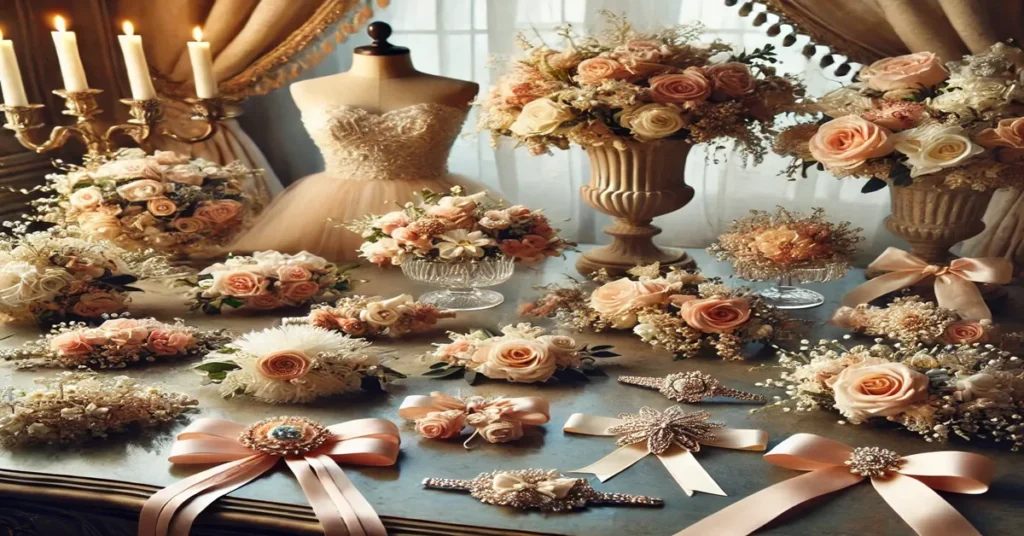A corsage is far more than a mere floral arrangement; it is a timeless symbol of tradition, elegance, and heartfelt sentiment. Whether accentuating the wrist of a prom-goer or the lapel of a wedding guest, corsages have consistently been at the forefront of special moments, blending charm with sophistication. These delicate creations, steeped in history, continue to be a cherished accessory for events ranging from intimate gatherings to grand celebrations. This article embarks on a journey through the fascinating history of corsages, exploring their diverse styles, their profound significance at various occasions, and practical insights for selecting and preserving these exquisite floral adornments.
The Historical Roots of Corsages
Corsages, derived from the French word “cors” (meaning body), originally referred to small bouquets worn on the bodice of a dress. Their history traces back to ancient Greece, where individuals wore flowers and herbs for protection against spirits and diseases. The practice evolved during the Victorian era, where corsages became an essential part of courtship rituals and social gatherings.
During the 19th century, corsages gained prominence as fashionable accessories at weddings and formal events. Men gifted corsages to their partners, symbolizing affection and admiration. These floral tokens were pinned to the bodice or worn as a wristband, becoming a hallmark of formal attire.
Types of Corsages
Corsages come in various forms, each suited to different occasions and personal preferences. Here are some of the most popular types:
1. Wrist Corsages
Wrist corsages are perhaps the most common type, often seen at proms and weddings. They are attached to a decorative elastic band or ribbon, making them comfortable to wear and easy to coordinate with an outfit. Popular flowers for wrist corsages include roses, orchids, and carnations.
2. Pin-On Corsages
These are traditional corsages pinned to the clothing, usually on the chest or shoulder. Pin-on corsages are a staple for weddings, often worn by mothers, grandmothers, and other honored guests.
3. Boutonnières
Technically a type of corsage, boutonnières are smaller floral arrangements worn on the lapel of a man’s jacket. They are typically chosen to complement the corsage of a partner.
4. Shoulder Corsages
Larger than the wrist or pin-on varieties, shoulder corsages are often chosen for formal evening gowns. They create a dramatic effect and are ideal for events requiring extra elegance.
5. Hair Corsages
These corsages are incorporated into hairstyles, adding a natural and whimsical touch. Hair corsages are popular at weddings and themed parties, blending seamlessly with intricate hairstyles.
Choosing the Perfect Corsage
Selecting the right corsage involves considering several factors to ensure it complements the wearer and the occasion:
1. Match the Outfit
The corsage should harmonize with the color, style, and formality of the outfit. Neutral or pastel-colored flowers work well with most dresses, while bold hues make a striking statement.
2. Consider the Occasion
For weddings, traditional white or pastel flowers like roses and lilies are preferred. Proms and parties offer more flexibility, allowing for creative and vibrant designs.
3. Personalize the Design
Incorporate favorite flowers or colors to make the corsage more meaningful. Adding embellishments like ribbons, beads, or rhinestones can also enhance its appeal.
4. Seasonal Availability
Opt for flowers that are in season to ensure freshness and affordability. Seasonal blooms also add an authentic touch to the arrangement.
5. Consult a Florist
Professional florists can provide valuable insights and create custom designs tailored to individual preferences and themes.
The Role of Corsages in Special Occasions
Corsages have a significant presence in various ceremonies and celebrations, each with its unique customs and meanings:
1. Weddings
Corsages are a staple at weddings, symbolizing honor and recognition for close family members and special guests. The mother of the bride and groom, grandmothers, and sometimes bridesmaids wear corsages that match the wedding’s floral theme.
2. Proms
High school proms are synonymous with wrist corsages. Traditionally, a young man gifts a corsage to his date as a gesture of admiration. Modern prom-goers often coordinate corsages with their attire to create a cohesive look.
3. Mother’s Day and Anniversaries
Corsages are a popular gift for Mother’s Day and anniversaries, symbolizing love and appreciation. They add a sentimental touch to these heartfelt occasions.
4. Formal Events and Galas
At formal gatherings, corsages elevate the elegance of an outfit, serving as a subtle yet sophisticated accessory.
5. Funerals
Corsages are also worn at funerals to honor the deceased. White flowers, such as lilies or chrysanthemums, are commonly used to symbolize purity and remembrance.
Crafting a DIY Corsage
Creating a corsage at home can be a rewarding experience. Here’s a step-by-step guide:
Materials Needed:
- Fresh flowers
- Floral tape
- Floral wire
- Ribbon
- Scissors
- Glue gun (optional)
Steps:
- Select Flowers: Choose sturdy flowers that can withstand handling and maintain freshness throughout the event.
- Prepare the Flowers: Trim the stems to about 2 inches and remove excess leaves.
- Arrange and Secure: Arrange the flowers in a pleasing composition and secure them with floral tape.
- Add Embellishments: Attach decorative elements like ribbons or beads for added flair.
- Attach to Base: For wrist corsages, attach the arrangement to an elastic band. For pin-on corsages, secure a pin to the back.
Preserving Corsages as Keepsakes
Corsages often hold sentimental value, making them worth preserving. Here are some methods:
1. Pressing
Press the corsage between heavy books with parchment paper to flatten and dry it. This method works well for small flowers and leaves.
2. Drying
Hang the corsage upside down in a dry, dark place for several weeks. Once dried, it can be displayed in a shadow box or frame.
3. Freezing
Use silica gel to freeze-dry the corsage, preserving its color and shape. This method is ideal for intricate arrangements.
Modern Trends in Corsages
Corsages continue to evolve with changing fashion and cultural trends. Some notable modern trends include:
1. Non-Traditional Flowers
Unique blooms like succulents, proteas, and wildflowers are gaining popularity, adding a contemporary twist.
2. Eco-Friendly Designs
Sustainable materials and locally sourced flowers are becoming a preferred choice for environmentally conscious individuals.
3. Creative Arrangements
Incorporating elements like feathers, pearls, or even miniature figurines allows for a highly personalized touch.
4. Gender-Neutral Options
Corsages are increasingly designed with inclusivity in mind, catering to a diverse range of preferences and styles.
Conclusion
Corsages are timeless accessories that carry deep-rooted traditions and personal significance. Whether adorning a wrist, shoulder, or lapel, they bring an element of grace and meaning to any event. From understanding their history to choosing or crafting the perfect arrangement, corsages remain an enduring symbol of celebration and sentiment.
Read: Legacy of Hawk Tuah Hat: Cultural and Historical Significance
FAQs
1. What is a corsage?
A corsage is a small floral arrangement worn on the wrist, pinned to clothing, or integrated into a hairstyle. It is commonly used at weddings, proms, and other formal events.
2. How do you choose the right flowers for a corsage?
Choose flowers that match the color and style of the outfit, suit the occasion, and are in season. Personal preferences and symbolic meanings can also guide the selection.
3. How long does a fresh corsage last?
A fresh corsage typically lasts about 24 hours if kept cool and hydrated. Refrigerating it before use can help maintain its freshness.
4. Can you make a corsage at home?
Yes, with basic materials like flowers, floral tape, and ribbons, you can create a DIY corsage. This allows for personalization and cost savings.
5. What occasions are corsages used for?
Corsages are used for weddings, proms, Mother’s Day, anniversaries, funerals, and other formal or sentimental events.
6. How can I preserve a corsage as a keepsake?
You can preserve a corsage by pressing it, drying it, or using silica gel for freeze-drying. These methods retain its sentimental value and beauty.







